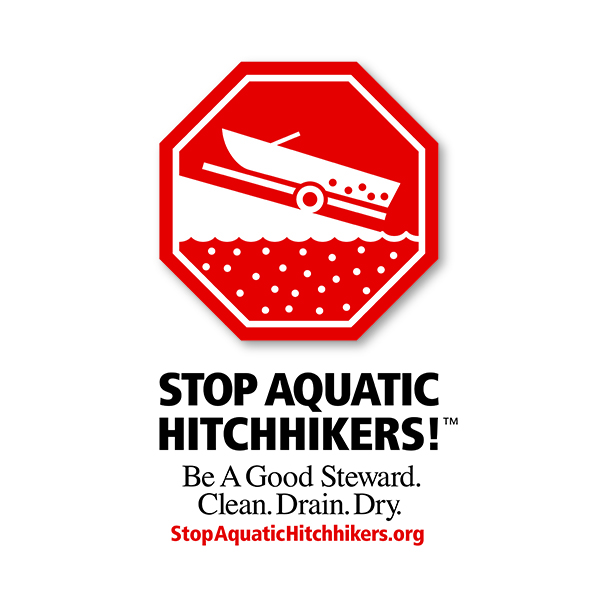
June 01, 2020| Environment
By: Stop Aquatic Hitchhikers national campaign
Stop Aquatic Hitchhikers! is a national campaign that helps recreational water users be part of the solution to help prevent and slow the spread of aquatic invasive species.
Recreational activities such as recreational boating, angling, and even swimming may spread aquatic invasive species - non-native plants and animals that have been introduced to our waters and that can limit our ability to recreate, diminish our fishing opportunities, and degrade the waters we enjoy.
Recreational boats are one way that unwanted species are moved between waters. Some aquatic invasive species can attach to boats, while others can become tangled on propellers, anchor lines, or boat trailers. Many species can survive in bilge water, ballast tanks, and motors or may hide in dirt or sand that clings to nets, buckets, anchors, and waders. Fortunately, completing simple steps can prevent the transport of aquatic invasive species. Remember to Clean, Drain, Dry… In every waterbody, every time.

Clean, Drain, Dry… In every waterbody, every time.
Preventing the spread of aquatic invasive species starts with you. A cooperative effort is necessary by all persons and agencies involved with recreational activities to achieve the best results and protect our aquatic resources and recreational opportunities.
The general Clean Drain Dry procedure is described below; however, keep scrolling down the page for information pertaining to specific recreational activities.
CLEAN off visible aquatic plants, animals, and mud from all equipment before leaving water access
Rinse equipment and boat hulls (with high pressure, hot water when possible)
Rinse interior compartments of boats with low pressure, hot water (120°F)
Flush motor with hot water (120°F) for 2 minutes (or according to owner’s manual)
DRAIN motor, bilge, livewell, and other water-containing devices before leaving water access.
DRY everything for at least five days OR wipe with a towel before reuse.
For ANGLERS, the additional step of DISPOSE is recommended:
Together the three steps of Clean Drain Dry greatly minimizes the risk of spreading Aquatic Hitchhikers into new locations.
Cleaning will remove visible large-bodied organisms attached to or in watercraft or recreational equipment. Rinsing with water removes organisms, while hot water often kills them. Water at least 120°F is recommended; be sure to avoid contact with skin and check manufacturers’ recommendations to ensure equipment can withstand high temperatures. If hot water is not available or may cause damage, rinsing with tap water and completely drying will help prevent the spread of aquatic invasive species.
Draining removes small and nearly invisible organisms such as zebra mussel larvae (veligers) potentially entrained in water containing devices.
Drying is necessary as many organisms can survive in standing water.
A note about chemicals. The use of chemical prophylactics or disinfectants (e.g., bleach) is not recommended for treating watercraft and recreational equipment. Chemicals may:
Damage equipment or components
Cause environmental damage
Harm human health
May not be effective against many aquatic invasive species
CLEAN off visible aquatic plants, animals, and mud from watercraft, motor, trailer, and equipment before leaving water access. Scrub hull using a stiff brush. Rinse watercraft, trailer, and equipment with high-pressure hot water when possible. Flush motor according to owner’s manual.
Jet Boats and Personal Watercraft (PWCs) users: Clean off visible aquatic plants, animals, and mud from hull, trailer, intake grate and steering nozzle, etc. Run engine 5-10 seconds to blow out excess water and vegetation from internal drive before leaving water access.
Sailors: Clean off visible aquatic plants, animals, and mud from the centerboard, bilge board wells, rudderpost, trailer and other equipment before leaving water access.
DRAIN water from watercraft, motor, bilge, bladder tanks, livewell, and portable bait containers before leaving water access.
DRY everything for five days or more, unless otherwise required by local or state laws, when moving between waters to kill small species not easily seen OR wipe with a towel before reuse.
For canoes, boards, rafts, kayaks, rowboats, paddleboats, inflatables, sculls, and other non-motorized recreational watercraft:
CLEAN off visible aquatic plants, animals, and mud from watercraft, gear, paddles, floats, ropes, anchors, dip nets, and trailer before leaving water access. Scrub hull using a stiff brush. Rinse watercraft, trailer, and equipment with high-pressure hot water, when possible.
DRAIN water from watercraft, sponges, bailers, and water containing devices before leaving water access.
DRY everything five days or more, unless otherwise required by local or state laws, when moving between waters to kill small species not easily seen OR wipe with a towel before reuse.
CLEAN off plants, animals, and mud from gear and equipment including waders, footwear, ropes, anchors, bait traps, dip nets, downrigger cables, fishing lines, and field gear before leaving water access. Scrub off any visible material on footwear with a stiff brush.
DRAIN water from watercraft, motor, bilge, bladder tanks, livewell, and portable bait containers before leaving water access. Replace with spring or dechlorinated tap water when keeping live bait before leaving water access.
DRY everything five days or more, unless otherwise required by local or state laws, when moving between waters to kill small species not easily seen OR wipe with a towel before reuse.
DISPOSE of unwanted bait, fish parts, and packing materials, in the trash; do not dump them in the water or on land.
Other key actions:
Use non-felt soled boots to further reduce the risk of spreading aquatic invasive species.
Fish caught for eating or taxidermy should be cleaned at designated fish cleaning stations or placed on ice.
Never dump live fish or other organisms from one water body into another.
CLEAN off visible plants, animals, and mud from swimsuits, masks, goggles, floats, and beach toys.
DRAIN water from toys or other water-containing devices before leaving water access.
DRY everything five days or more, OR wipe with a towel before reuse.
Aquarium and Pet Owners:
Many people think their fish, reptiles, or other aquatic species will survive if they turn them loose in local water. Unfortunately, many of these species do survive, reproduce, and become invasive. As an alternative to release, find another owner, donate to a pet shop or humane center, or humanely euthanize. In addition, never empty water from your fish tank into a water body or storm drain; instead pour water into the toilet or onto land far away from bodies of water.
Bait Harvesters:
In addition to the bait itself being potentially invasive, other, potentially invasive, species can be collected with baitfish. If moved, they can negatively affect waterbodies. Use these measures to reduce the risk of transporting aquatic invasive species.:
Inspect for and remove undesired species.
Dispose of unwanted live bait in the trash.
Never release bait or aquatic plants into different waters.
Clean Drain Dry boats, trailers, and equipment before leaving the access point.
Tourists:
Individuals travel to other states and countries around the world. If you have entered the water in your travels, be sure to clean anything that came in contact with that water including shoes, boots, waders, boats, and trailers. You do not want to be responsible for bringing something that may be destructive into your home area. Also, make sure you clean your items before leaving on a trip so that you do not inadvertently introduce an invasive species to the area you plan to visit.

April 15, 2025
Environment, Events

April 11, 2025
Community, Events, Fundraising